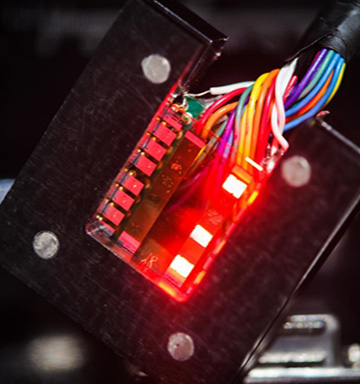
Nanoparticles of perovskites drive new, highly efficient type of LED. [Image: Sameer A. Khan/Fotobuddy]
Scientists are vigorously exploring how metal halide perovskite films can improve many optical technologies, from solar cells to lasers. Now, a U.S. research team has developed a new method for creating fine-grained perovskite films suitable for LEDs (Nature Photon., doi:10.1038/nphoton.2016.269).
Shrinking size, increasing efficiency
Perovskites, the synthetic versions of a naturally occurring mineral, can act as semiconductors, depending on their exact crystalline structure. Their tunable bandgap and high color purity could make perovskite films a low-cost substitute for gallium nitride in LEDs. Previous studies of the radiative-recombination rate in 3-D perovskite crystals suggest that ultrathin perovskite films or small perovskite grain sizes are needed for LED efficiency. However, existing processing methods produce coarse-grained, rough-surfaced films, with particle sizes in the hundreds of nanometers.
When making the perovskite crystals, Barry P. Rand and his colleagues at Princeton University added long-chain ammonium halides, with either iodine or bromine as the halogen, to the precursor solution. Acting as a surfactant, the ammonium halides not only shrank the perovskite grain size to around 10 nm, but also made the grains’ crystalline structures more 2-D. The roughness of the resulting films was less than 1 nm.
The LEDs made from the smooth perovskite films gave off stronger and bluer light than previous perovskite light emitters. The external quantum efficiency was 10.4 percent for the iodide perovskite LEDs and 9.3 percent for the bromide perovskite LEDs.
The long run
Another important metric for future applications of perovskite LEDs is their “shelf stability”—their ability to emit the advertised amount of light even after sitting unused for a while. (No one wants to buy LED lamps that turn out to be dimmer than expected.)
According to the Princeton team, perovskite LEDs made without ammonium halide lose roughly a third of their external quantum efficiency after sitting in a nitrogen-filled compartment for as little as two days, whereas the iodide perovskite LEDs maintained their efficiency after eight months of storage. Similarly, the bromide perovskite LEDs remained shelf-stable after four months. The researchers suggest that long-chain ammonium cations may also boost perovskite performance in other optical applications, such as photovoltaic cells.
